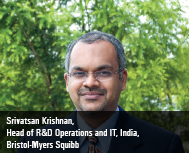
CIOTechOutlook >> Magazine >> December - 2015 issue
Convergence of Business Operations and IT - A Systems Thinking Perspective
By
 Bristol-Myers Squibb, headquartered in Bangalore, Karnataka, is a biopharmaceutical company that provides medicines for cancer, cardiovascular disease, hepatitis B, HIV/AIDS and rheumatoid arthritis.
Bristol-Myers Squibb, headquartered in Bangalore, Karnataka, is a biopharmaceutical company that provides medicines for cancer, cardiovascular disease, hepatitis B, HIV/AIDS and rheumatoid arthritis.In today's complex world, successful organizations are those that deliver outcomes of value to stakeholders consistently and quickly. The rapid rate at which business happens requires that strategy be translated into operation quickly with the relevant feedback loops in place at the strategic, tactical and daily operational levels. The faster an organization is able to process information and act appropriately, the better it will be differentiated within quick moving ecosystems. The faster that a series of seemingly unrelated ongoing activities approach a finite business outcome, the better it is.
What better an enabler than IT, working with armies of electrons at close to the speed of light, making this convergence possible!
Let us take the use case of operations at a laboratory-centric business workplace. A laboratory leader may be having a conversation that goes something like this –
“What lab operations are we going to execute that helps add value? How will we measure ourselves? What quality? What about our data?
Where will the lab be located? What will the lab look like?
What type of people will we need, how will we hire the folks we need, where will we hire them from? What chemicals and reagents will we need? Where will they be sourced from? What equipment and infrastructure will be needed? How will the equipment be supported, what support systems will be needed, who will support these people and infrastructure? What can we outsource? What can be done using contract staff?
How will our scientists reach out for support? How will we train them? What training needs will exist?
How can we measure uptime? How can we minimize downtime? How can we measure responsiveness of the support systems? How can we prolong life expectancy of our equipment and facilities?
How will we generate demand for our products and services? What regulations will apply? What safety measures, physical and virtual, will be necessary?” And so on…
The answers and execution, of course, are contextual.
This imaginary conversation – could be in any business domain, the nouns may vary but the story line probably applies whether its labs, e-tail/retail, hospitals, manufacturing etc. - provides an idea about the variety of disciplines needed to arrive at a common goal - at the same time - before the first iota of usable product or information can be generated from any operation in support of a business objective.
A typical operation conceived out of the thought process described above, requires at a bare minimum, a tapestry of business processes, laboratory Subject Matter Experts (SME) in more than one flavor quite possibly, Human Resources recruiters, trainers, talent managers, Scientific Managers trained to be managers, Laboratory equipment support SMEs, safety experts, facilities engineering SMEs personnel, data scientists to analyze and make sense out of raw data, Supply Chain SMEs, Lab IT systems personnel and Lab Applications SMEs, all working with a common focus. Every process has a direct or indirect impact upon business outcomes.
Information makes weaving a tapestry possible at the appropriate business velocity
These questions brings into play HR systems, Social Media, Communication and Collaboration Systems, facilities design software, Building Automation Systems, Lab Asset Management systems, Change Management systems, Business Process Management tools, Electronic Lab Notebooks, Instrumentation Control Software, Help Desk tools, Scientific Analysis software, Metrics Reporting, Financial Management, Supply Chain Management, Procurement tools, Resources and Project Management tools to make such a concert happen. Throw in Internet of Things and a cloud or two for good measure in today’s global business world.
In our technology-ubiquitous world and tech-savvy multi-disciplinary workforce, what is becoming vital, not optional, is for relevant IT enablers to be woven seamlessly into business processes. It takes the proverbial conductor(s), well versed in Information Technology and Business arts to make such a symphony possible!
Alignment, a popular term in business parlance, is increasingly substituted with the need for quick convergence. No longer is it possible to act in silos. In generations past, management theories may have centered on assembly lines operations may have identified departments and handoffs as being necessary to keep the production lines going. Not so anymore, in a knowledge-centric universe of ours, where many activity streams are required to provide a holistic solution, with information being generated and directed toward a common focus, asynchronously quite possibly. Thus, a unique combination of knowledge workers within blurry organizational lines, data, technology, infrastructure and workplace is required for differentiation and organizational sustainability. And Culture of course.
A well-run business is like a self-conducting orchestra with IT being the music that makes the Business Operations concert series possible every day.
CXO Insights
Profitable Behaviours for Successful Sales
By Venkat Malladi, Co-Founder & CTO, Vymo
AI-AS-A-Service, Big Data & RPA To Transform...
By Anil D Souza, Founder & CEO, Simpliance Technologies
Contineo: Riding the Washington Accord Wave




